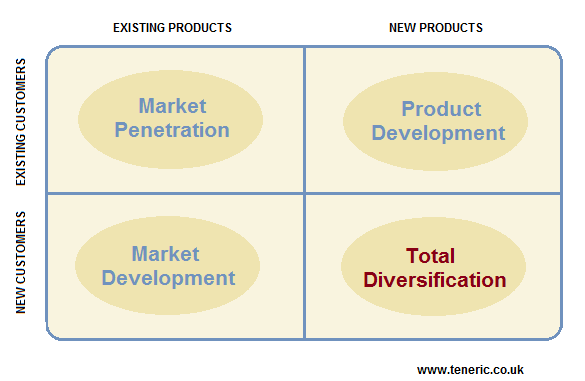
Businesses struggling for new customers in declining markets may need to start thinking differently to increase profits over the longer term. This planning communication tool originated from the Russian Mathematician Igor Ansoff showing the four alternative growth areas a company could follow. Pictured below is the basis of the Ansoff Matrix.

As market conditions change over time, a product or service that was previously in high demand may require your attention. Advances in technology, competitor changes or pricing promotions could make your product obsolete.
The matrix above could help you find new market opportunities. Here’s how to use the information gathered from your company.
| Strategy | Description |
|---|---|
| 1: Market Penetration | Market penetration is the least risky strategy of the four quadrants. You’re just selling your existing products to your current customers using existing sales channels. You know what works, what motivates people to buy, and the dynamics of the markets. |
| 2: Market Development | The market development option helps you sell your existing goods and services into brand new markets. Your product will need to adapt to the demands and needs of the new market sector you’re targeting together with changes to your marketing communications material. |
| 3: Product Development | A product development strategy involves developing your existing customer base to offer them entirely new products. This approach has slightly more risks as your consumers may reject your ideas. With all sectors, it’s best to undertake market research before any product launch. |
| 4: Total Diversification | The diversification quadrant is an area most companies stay away from, but some companies attempt to reinvent themselves by selling completing new products to brand new customer groups. This area is a high-risk strategy that requires extensive planning and control. |
Now we’ve explained the basis of each quadrant, below are reasons as to why companies may choose each strategy.
Most companies feel safe in this segment because it’s just a case of doing more of the same successful selling strategies. Selling more or additional products to your existing customer base is the easiest strategy to follow. Keep targeting customers to buy more of the same product through your existing communications channels. The reasons companies follow this course of action are:
For many, this approach is all about survival because it’s the area your business knows the best with the bulk of generated revenues. It’s a protected segment because it’s your core business. If the market is in continual decline or likely to disappear because of legislative or technological changes, then some of the other quadrants come into play.
This growth strategy is about targeting new groups of customers with your existing products. Marketing theorists term this method “market development”. There are many avenues to explore such as:
You should approach overseas markets with a degree caution due to potentially different cultures and working practices that may limit your growth.
The third method to develop an existing business is to sell new products to your current customer base.
Many customers are loyal to your company because they’ve purchased from you before. They’ll be more receptive to new ideas, especially if you’ve previously researched their requirements. Some types of product development include:
Most academics suggest researching your customers for product development ideas, but sometimes they won’t know what they want. There’s always a risk attached to change, so testing ideas in larger groups should enable you to decide whether to launch new innovations into your market.
The target marked red in the matrix shown above is for those companies looking to diversify from their current market. Targeting this area can be a dangerous strategy as it requires new products to be developed and sold to customers in an entirely new marketplace. The company and management team most likely won’t have the experience to diversify; hence the increased risk.
There are not many companies who have succeeded with this strategy, but plenty who have failed.
Questions you may want to ask before heading down this route are: